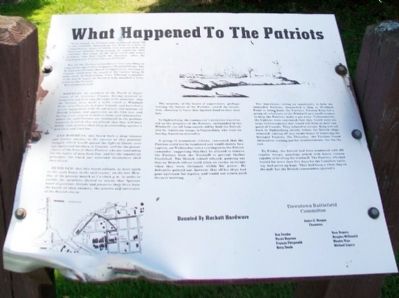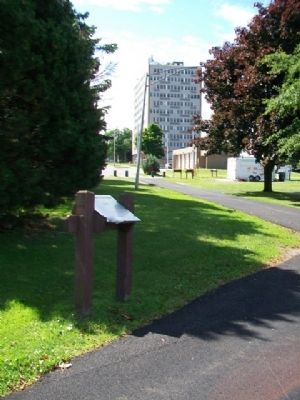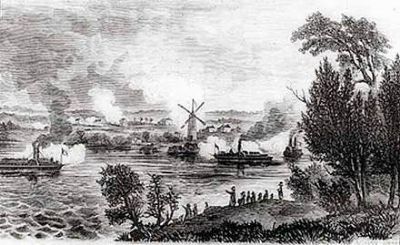Ogdensburg in St. Lawrence County, New York — The American Northeast (Mid-Atlantic)
What Happened To The Patriots
Ogdensburg Battlefield Trail
Even though the Patriots only numbered about 180 in the windmill, Ogdensburg was home to a host of sympathizers, many of whom were prevented by the American infantry from joining or supplying their comrades. But many of the most vocal and active members who had urged the invasion, when the fighting began, were no where to be found.
Not all the Patriot sympathizers were unwilling to come to the aid of those trapped at Windmill Point. The St. Lawrence County Board of Supervisors, meeting in Canton, could hear the sound of the cannon firing 20 miles away in Ogdensburg. Isaac Ellwood, a member of the board, urged the board to help marshall a force to rescue the Patriots. His resolution read:
Whereas, the members of the Board of Supervisors of St. Lawrence County, having received information and believing the same to be authentic, that the Patriots have made a noble stand at Windmill Point, near Prescott, in Upper Canada, and have had a severe engagement with the advocates and minions of British tyranny and oppression on the 13th inst. and having every reason to believe from said information, unless the said Patriots are reinforced in the perilous situation in which they are placed, that they will meet defeat, and sacrifice their lives in contending against a merciless and cruel foe:
And whereas, this board feels a deep interest and intense anxiety in the success of that patriotic struggle which would spread the light of liberty over our oppressed brethren in Canada, and for the preservation of the lives of those Patriots who are contending for the rights of men born free, and for the republican principles for which our venerable forefathers shed their blood,
Resolved, that this board adjourn, to meet again at the court house in the said county, on the last Monday of the present month at 1 o'clock p.m. in order to enable the members thereof to rescue that Spartan band of patriotic friends and preserve their lives from the hands of their enemies, the tyrants and advocates of the British crown.
The majority of the board of supervisors, perhaps sensing the future of the Patriots, tabled the resolution, choosing to leave that Spartan band to face their fate.
In Ogdensburg, the community's attention was riveted on the progress of the Patriots, surrounded in the Windmill, cut off from outside aid by both the British, and by American troops in Ogdensburg who were enforcing American neutrality.
A group of prominent citizens, concerned that the Patriots could not be reinforced and would shortly face capture, on Wednesday sent a contingent to the British commander, suggesting that they be allowed to remove the Patriots from the Windmill
to prevent further bloodshed. The British colonel refused, pointing out that no British officer could allow an enemy to escape when they were obviously within his power. He delicately pointed out, however, that all his ships had gone upstream for repairs, and would not return until the next morning.
The Americans, seeing an opportunity to help the embattled Patriots, dispatched a ship to Windmill Point to bring home the Patriots. Preston King led a group of volunteers to the Windmill on a small steamer to help the Patriots make a get away. Unfortunately, the fighters were convinced that they would soon see large reinforcements that would aid them in their conquest of Canada. They refused to escape. King arrived back in Ogdensburg shortly before the British ships returned, cutting off any future hopes of removing the besieged Patriots. On Thursday, the Patriots found themselves waiting not for reinforcements, but for the end.
By Friday, the British had been reinforced with 400 regular troops, gunships armed with heavy cannon capable of leveling the windmill. The Patriots, who had waited for more than five days for the Canadian uprising, had given up hope. They had hung a white flag on the mill, but the British commanders ignored it.
Erected by Hackett Hardware and the Downtown Battlefield Committee.
Topics. This historical marker is listed in these topic lists: Disasters • Patriots & Patriotism.
Location. 44° 42.01′ N, 75° 29.696′ W. Marker is in Ogdensburg, New York, in St. Lawrence County. Marker is along the walking path west of the tennis courts in Morissette Park, about 200 feet north of the intersection of Riverside Avenue and State Street. Touch for map. Marker is in this post office area: Ogdensburg NY 13669, United States of America. Touch for directions.
Other nearby markers. At least 8 other markers are within walking distance of this marker. Benjamin Forsyth: The Daring Commando (a few steps from this marker); Ogdensburgh And The War (a few steps from this marker); The Attack on the Village (within shouting distance of this marker); Sheriff Joseph York’s Stand (within shouting distance of this marker); North Country Sailors' Memorial (within shouting distance of this marker); Attack on the Fort (about 400 feet away, measured in a direct line); Civil War Soldiers' and Sailors' Memorial (about 400 feet away); How Ogdensburgh Captured Brockville (about 500 feet away). Touch for a list and map of all markers in Ogdensburg.
Also see . . .
1. Rebellion in Lower Canada (The Patriots' War). Canadian Encyclopedia entry:
In 1837 and 1838, French Canadian militants in Lower Canada took up arms against the British Crown in a pair of insurrections. The twin rebellions killed more than 300 people. They followed years of tensions between the colony’s anglophone minority and the growing, nationalistic aspirations of its francophone majority. (Submitted on June 22, 2023, by Larry Gertner of New York, New York.)
2. Battle of the Windmill National Historic Site of Canada. Parks Canada website entry (Submitted on July 27, 2014, by William Fischer, Jr. of Scranton, Pennsylvania.)
Credits. This page was last revised on June 22, 2023. It was originally submitted on July 27, 2014, by William Fischer, Jr. of Scranton, Pennsylvania. This page has been viewed 376 times since then and 9 times this year. Photos: 1, 2, 3. submitted on July 27, 2014, by William Fischer, Jr. of Scranton, Pennsylvania.


